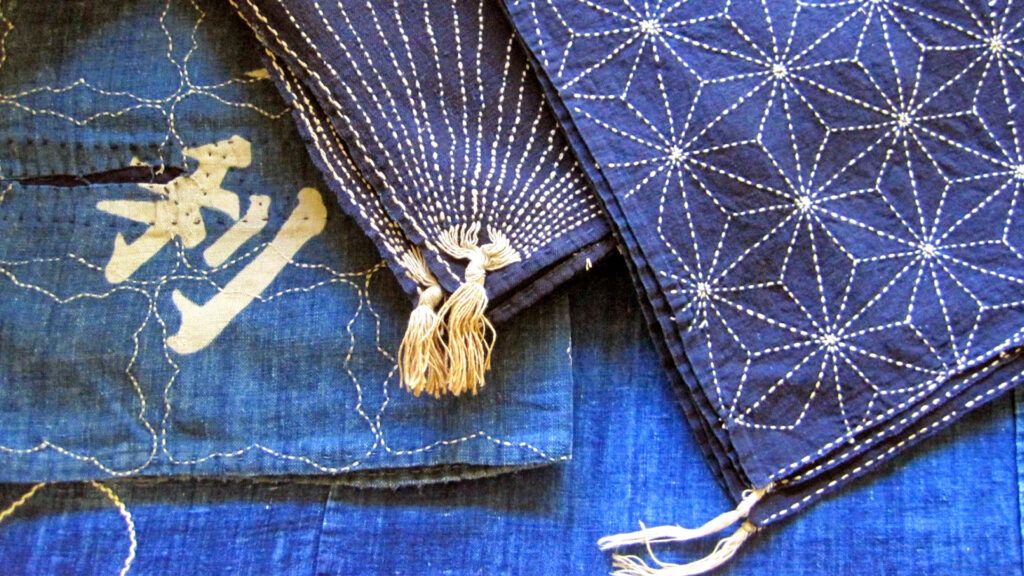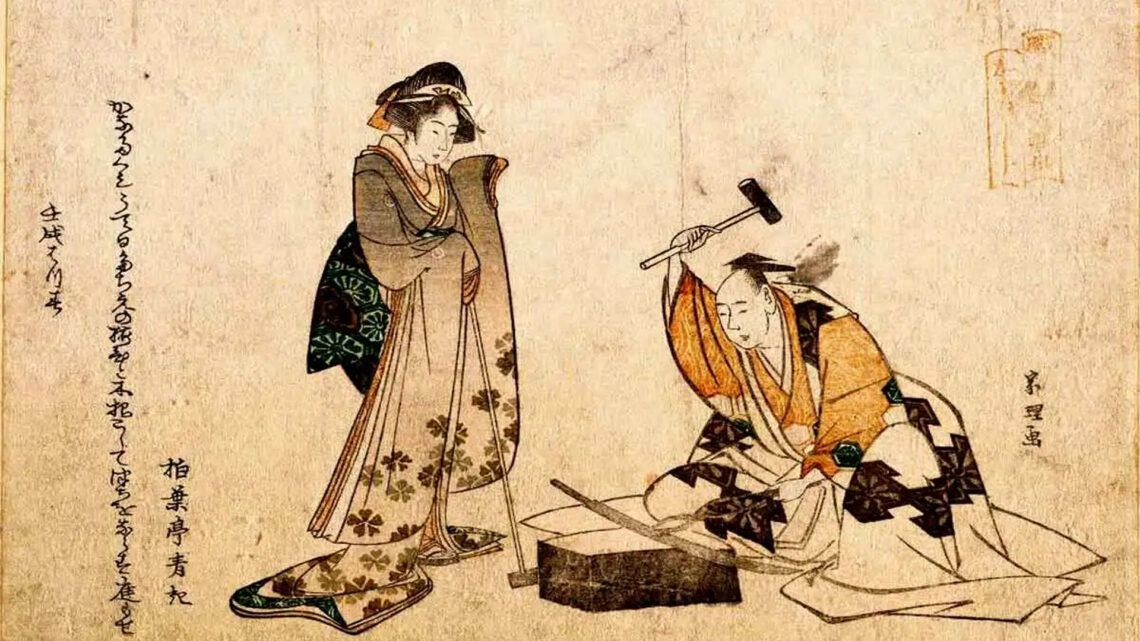
Sashiko and Zen: The Art of Mindfulness and Creativity
Sashiko – the Japanese art of embroidery that is deeply rooted in Japanese culture and philosophy. Let’s delve into the world of Sashiko and Zen, their significance, history, and the way they are intertwined.
Sashiko: The Art of Elegant Repair
Sashiko, literally translated as “little stabs,” is a traditional Japanese craft that originated centuries ago. Born out of necessity, Sashiko evolved into a refined technique of textile reinforcement and decoration. Passed down through generations, this technique is now an integral part of Japanese textile art.
At the heart of Sashiko lies the concept of reuse and sustainability. In the past, these techniques were used to repair clothing and fabrics, extending their lifespan. What began as a necessity transformed over time into an art form. Sashiko stitches are not only functional but also visually appealing. The distinctive white stitches on dark fabric create an elegant geometric pattern that captures attention.
The selection of patterns in Sashiko is not random. Often, motifs are chosen for their deeper symbolic meanings. For example, wave patterns might represent the flow of life, while geometric shapes symbolize harmony and balance. These patterns often reflect the connection between humans and nature, a central concept in Japanese culture.
Zen: The Art of Meditation and Mindfulness
While Sashiko enriches the world of textile art, Zen shapes the spiritual landscape of Japan. Zen, a Buddhist school, emphasizes the importance of meditation and mindfulness in achieving enlightenment. This practice has deep roots in Japanese society and influences many aspects of daily life, from art and architecture to tea ceremonies.
Zen philosophy teaches us to live in the present moment and perceive the world around us with keen awareness. This idea is reflected in the Sashiko technique, which requires patience and devotion. When embroidering Sashiko, the artist focuses on each individual stitch, on every movement of the needle. This concentration resembles meditation, where the mind is focused on a single point.
The simplicity of Zen aesthetics also strongly influences the art of Sashiko. Both traditions value beauty in the minimalist and imperfect. In Zen philosophy, there’s the concept of “Wabi-Sabi,” describing the beauty of impermanence and imperfection. This concept is also evident in the aesthetics of Sashiko, where hand-stitched irregularities are seen as part of the charm.
The Connection: Craftsmanship and Mindfulness
The connection between Sashiko and Zen is subtle but profound. Both practices demand mindfulness and dedication. Both in stitching Sashiko and in practicing Zen, the essence is about dwelling in the moment, acting consciously, and establishing a deep connection to one’s action.
The stitches in a Sashiko pattern can be seen as a metaphor for the many steps on the path to enlightenment. Each stitch requires patience, concentration, and a steady hand. Similarly, Zen practice requires endurance and discipline to calm the mind and attain inner clarity.
Sashiko and Zen are also akin in their ability to soothe the soul. While stitching Sashiko, the artist can enter a meditative state where everyday stress can fade away. Zen meditation strives for a similar calm and inner peace. It’s no coincidence that many people seeking tranquility in the midst of the modern world are drawn to both Sashiko stitching and Zen meditation.
The Depth of Traditions: History and Modernity
The roots of Sashiko reach deep into Japan’s history. It developed in rural communities as a way to reinforce clothing and fabrics in harsh conditions. The distinctive white stitches on indigo fabric served not only for mending but also as a means to bring beauty and individuality to plain materials. Over time, Sashiko evolved into an art form that went beyond practical application and offered aesthetic enjoyment.
Zen, on the other hand, was founded in 6th-century China and made its way to Japan in the 12th century. It became a significant force in Japanese culture, influencing art, architecture, martial arts, and many other realms of life. Zen practice emphasizes direct experience and the attainment of insight through personal experience, rather than relying solely on theoretical knowledge.
In the modern world, both Sashiko and Zen have experienced remarkable transformations. Sashiko, once a practical necessity, is now often celebrated as an art form and can be found in modern designs and fashion collections. Zen has found refuge in today’s fast-paced world for those seeking inner calm and serenity. Zen centers and meditation groups are present in many countries, and Zen teachings have become a source of inspiration for people from diverse backgrounds.
The Meditative Art of Sashiko
Let’s delve deeper into how Sashiko can become a meditative practice. The process of Sashiko stitching requires gentle concentration and being present in the moment. As the needle pierces the fabric, a rhythmic pattern of stitches emerges, akin to the breaths of a tranquil mind. Hands move in harmony with the breath, while the gaze remains fixed on the flowing progress. In this process, worries can fade, and the mind can engage with the simple beauty of the stitch pattern.
The selection of patterns in Sashiko can also carry deeper meanings. Some patterns, such as the “Asano-ha” pattern resembling a hemp leaf, were traditionally used to symbolize protection and luck. While the artist stitches these patterns, they can focus on the symbolism and cultivate positive thoughts. This echoes the Zen practice of mantra repetition, where a single word or phrase is repeated in a meditative manner to focus and calm the mind.
Zen and the Art of Being
In Zen, the pursuit of enlightenment is achieved through mindfulness, meditation, and self-reflection. Zen masters often teach through paradoxes, riddles, and questions meant to lead the mind beyond the conventional. One of the most famous riddles is the “koan” – a question or statement often lacking a logical solution, pushing the mind to explore new thought patterns. A well-known koan asks, “What is the sound of one hand clapping?” The answer cannot be found through rational analysis but through direct immersion in the experience of the moment.
This type of thinking is also present in the Sashiko practice. The art of Sashiko requires an intuitive approach. As the artist stitches the pattern, they cannot rely on rigid rules or strict plans. Each stitch is a decision in the moment, a response to the fabric’s structure and the stitches that came before. Similar to Zen, this demands a dedication to present experience and an openness to what unfolds.
The Interplay of Sashiko and Zen in Creativity
The connection between Sashiko and Zen becomes particularly evident in creative practice. Both traditions value the beauty of the handmade, the imperfect, and the natural. In Sashiko, this beauty is found in the irregular stitches and subtle imperfections that reflect the handwork. In Zen, the nature of the mind is seen as unadulterated and pure, like a mirror reflecting everything without bias.
When artists immerse themselves in Sashiko, they can attain a meditative flow. The rhythmic repetition of stitches can work similarly to a mantra in Zen meditation. The mind calms down as the hands work in an almost automatic pattern. This can lead to a state of heightened creativity, where ideas and inspiration naturally emerge.
Lessons for Modern Life
Both Sashiko and Zen offer valuable lessons that can be applied to modern life. In a time when the world can often be hectic and overwhelming, these traditions provide paths to find inner peace and clarity.
The practice of Sashiko teaches us patience, endurance, and the beauty of simplicity. It reminds us that repairing and reusing things is not only environmentally friendly but also a way to establish a deeper connection with our belongings. The mindfulness required in Sashiko stitching can be transferred to other areas of life, whether it’s eating, walking, or simply being.
Zen teaches us to cherish the moment and free the mind from unnecessary baggage. Zen practice fosters a profound connection to one’s own experience and urges us to observe the world around us with open eyes. These teachings are invaluable in modern life, where distractions are ubiquitous and the ability to be present is often lost.
Conclusion: Craftsmanship and Spiritual Depth
Sashiko and Zen are two gems in the treasure trove of Japanese culture. While Sashiko embodies the art of craftsmanship, Zen embodies the art of being. Both traditions have their own uniqueness, but their connection is unmistakable.
As we immerse ourselves in the stitches of Sashiko or sit in the stillness of Zen meditation, we recognize the beauty and depth of these practices. We realize that they bring us not only aesthetic joy but also spiritual fulfillment. In a world often marked by hustle and superficiality, Sashiko and Zen remind us that true beauty and meaning are found in the simple, the momentary, and the conscious act.



